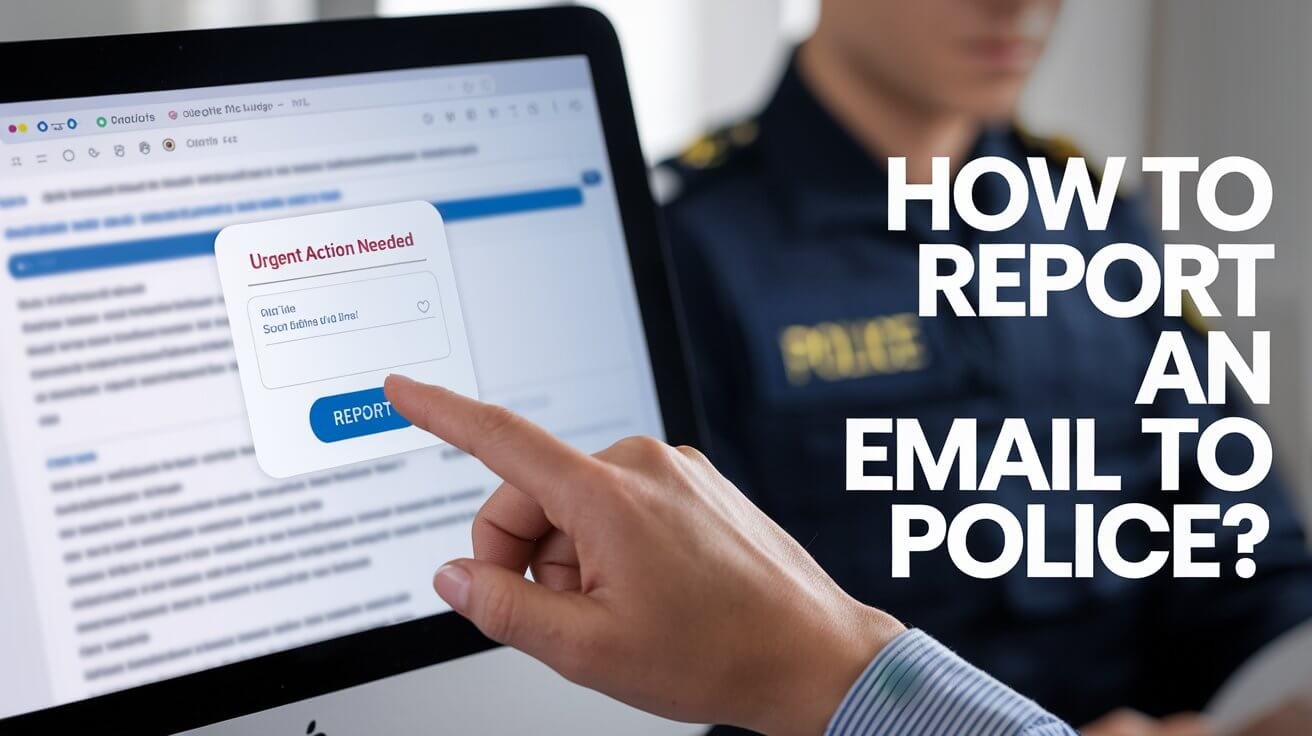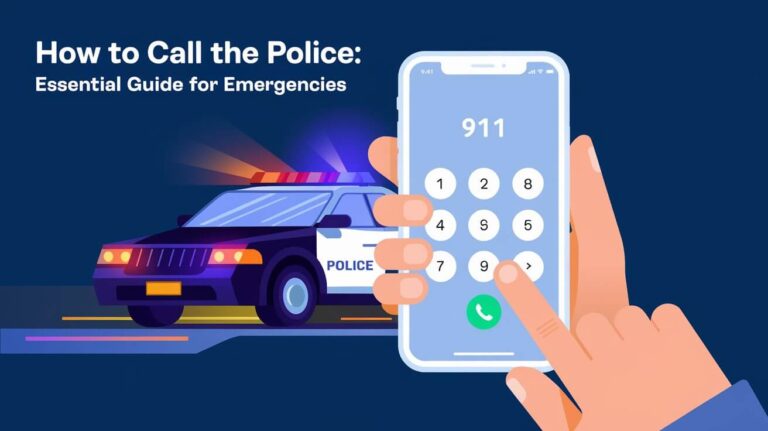How To Report An Email To Police: A Step-By-Step Guide

Reporting an email to the police is key to fighting cyber harassment and email crimes. If you’re facing threats online or social media stalking, acting fast is important. It helps prevent emotional harm like depression and anxiety, and even suicidal thoughts.
By filing a police report, you can stop the harasser from sending more emails. This could lead to fines or jail time, depending on the situation and where you live.
To begin, document all harassment, including email headers with the sender’s info and location clues. Block the harasser’s email and report the issue to the police. You can reach out to local police or the FBI’s Internet Crime Complaint Center (IC3) for help.
Provide detailed evidence like emails and logs for the investigation. Reporting an email crime can seem tough, but with the right help, you can protect yourself and your info from cyber harassment.
Types of Email Crimes Law Enforcement Investigates
Email crimes are a big problem, and police are fighting them. These crimes include email fraud, identity theft, and cyber harassment. Email fraud often involves phishing, where scammers try to get sensitive info like passwords or financial details.
Email Fraud and Scams
Email fraud and scams can cause a lot of harm. They can lead to financial losses and the theft of personal info. Examples include phishing emails, spam, and fake online deals.
Identity Theft Through Email
Identity theft through email is serious. Scammers use stolen info to open new accounts or buy things. Victims often don’t know their info has been stolen.
Email-Based Harassment
Email-based harassment is a form of cyberbullying. It includes threatening or scary emails. These emails can make victims feel scared and unsafe. It’s important to take these emails seriously and tell the police.
Some examples of email-based harassment include:
- Threatening emails
- Spreading nasty gossip online
- Stalking someone on social media
Evidence Collection Steps Before Filing a Report
Reporting an email crime starts with collecting evidence. This means getting all important info, like email headers and logging incidents. Email headers show who sent the email and when. Saving these can help the police solve the crime.
It’s also key to document everything. Make a log of incidents to track the crimes. This log should have details like when the crime happened, what it was, and more. A detailed log helps a lot when you file a report.
Some important steps to take when collecting evidence include:
- Saving email headers to provide police with sender information
- Creating a log of incidents to track the frequency and severity of crimes
- Documenting all relevant details, including dates, times, and types of crimes
Following these steps and collecting thorough evidence, including email logs, you can ensure that you have all the necessary information to file a report and aid in the investigation of the email crime.
Required Information for Email Crime Reports
When you file an email crime report, it’s key to give the police all the details they need. This helps them investigate and act against the criminals. You should include the sender’s email address and any other important info to track them down.
Also, a timeline of events is very important. This includes when you got the email and any talks with the sender after that. A detailed timeline helps the police see how things happened and find any patterns or links to other crimes.
Important Details to Add
- Sender details: email address, IP address, and any other relevant information
- Timeline of events: date and time the email was received, subsequent interactions with the sender
- Financial impact records: bank statements, credit reports, or other documents showing the financial impact of the email crime
Sharing this info, you help the police solve the email crime report. Remember, if it’s a phishing scam, tell your bank right away. This can stop more money loss.
| Type of Information | Importance | Example |
|---|---|---|
| Sender details | High | Email address, IP address |
| Timeline of events | Medium | Date and time the email was received |
| Financial impact records | High | Bank statements, credit reports |
How to Report an Email to Police: Step-by-Step Process
To report an email to the police, you need to follow a few steps. This helps you give all the info needed for a crime report. First, collect evidence like the email, any screenshots, and records of your talks with the sender.
The USAGov’s where to report a scam tool can guide you to the right place to report. You can also reach out to your local police to file a report. When you report the email, be ready to share all the details. This includes when you got the email, who sent it, and any other important info.
Here’s how to report an email to the police:
- Gather evidence: Collect all relevant information, including emails, screenshots, and documentation.
- Use the USAGov’s tool: Find the best agency or organization to report the scam.
- Contact your local police department: File a report and provide detailed information about the incident.
- Follow up: Check on the status of your report and provide any additional information as needed.
Remember to keep your personal info safe when reporting an email to the police. By following these steps, you help ensure your report is handled well. This way, you get the support you need to deal with the email crime.
| Agency | Contact Information |
|---|---|
| USAGov | where to report a scam tool |
| Local Police Department | phone number or online reporting platform |
| Federal Trade Commission (FTC) | 1-877-FTC-HELP (1-877-382-4357) |
Local Police Department Reporting Methods
Knowing how to report an email crime is key. Your local police department offers several ways to do this. You can choose the best method for your situation. These include in-person reports, online platforms, and phone calls.
In-Person Reports
Visit the police station to make an in-person report. This way, you can talk directly to an officer. It’s great for those who like a personal touch.
Online Reporting Platforms
Online platforms let you report from home. Many police departments have systems for this. It’s perfect for those short on time or who prefer online.
Phone Report Procedures
For emergencies, use the phone to report. Call the non-emergency number to speak with an officer. This is quick and easy.
Here’s a quick guide to the reporting methods:
| Reporting Method | Description |
|---|---|
| In-Person Reports | Visit the police station and speak with an officer |
| Online Reporting Platforms | Submit a report online through the police department’s website |
| Phone Report Procedures | Call the police department’s non-emergency number to file a report |
Understanding these methods helps you report efficiently. Choose the one that works best for you.
Federal Agency Reporting Channels
It’s important to know where to report email crimes. The Federal Trade Commission (FTC) and the Federal Bureau of Investigation (FBI) handle these cases. Reporting an email to them helps in catching and punishing the criminals.
Other agencies deal with specific email crimes. For example, the Anti-Phishing Working Group focuses on internet phishing. Here are some places to report email crimes:
- Contact the Federal Trade Commission (FTC) to report email fraud and scams
- Report email crimes to the Federal Bureau of Investigation (FBI) through their Internet Crime Complaint Center (IC3)
- Submit an email crime report to the Anti-Phishing Working Group to report internet phishing
When filing a report, give as much detail as you can. Include the sender’s info, a timeline, and any financial losses. Reporting email crimes helps stop more crimes and brings justice to victims.
Time Frames and Response Expectations
When you report an email to the police, knowing the time frames and what to expect is key. The time it takes for a response can change based on the crime’s severity and the police’s workload. For serious crimes, you should report them right away, but within 24 hours at the latest. For less serious ones, you have until the next business day.
The length of an investigation can differ, but it’s important to be patient. You should regularly check in with the police. This might mean calling them to see how the case is going or giving them more details. Knowing these time frames helps you plan and protect yourself and your information.
Key Considerations
- Initial response windows: vary depending on the severity of the crime and police workload
- Investigation duration: can vary, but patience and regular follow-up are essential
- Follow-up protocols: may include contacting the police department for updates and providing additional information
It’s important for the police to be open about their investigation. You should know how your case is progressing. By understanding the time frames and what to expect, you can handle the situation better. This ensures your concerns are looked into quickly.
Common Mistakes When Filing Email Crime Reports
Filing email crime reports can be tricky. Avoiding common mistakes is key to a smooth process. Giving incomplete or wrong info can slow down the case. Also, not saving emails or attachments makes it hard for police to find the culprits.
It’s easy to make mistakes when reporting crimes. Not following up or not giving more info as asked can happen. But, knowing the importance of accurate and timely reports is vital. This way, your report will be handled well and fast.
Here are some common mistakes to watch out for:
- Providing incomplete or inaccurate information
- Failing to save evidence, such as emails or attachments
- Not following up with the police or providing additional information as requested
- Not reporting the crime in a timely manner
Knowing these mistakes and avoiding them, you help your report get processed fast. This way, the bad guys can be caught. Always report to the right places, like the FBI’s Internet Crime Complaint Center (IC3), and give all the details you can.
| Type of Email Crime | Reporting Method |
|---|---|
| Phishing Scams | FBI’s Internet Crime Complaint Center (IC3) |
| Identity Theft | Federal Trade Commission (FTC) |
| Email-Based Harassment | Local Police Department |
Closing Thoughts
Reporting an email crime to the police is key to fighting cyber harassment and email-based offenses. Knowing the types of crimes the police investigate helps you gather evidence. This evidence is needed to file a report effectively.
The police can then look into the case and take steps to protect you. This helps prevent similar crimes in the future.
Even though reporting an email crime can seem hard, it’s very important. It helps keep our online communication safe. By following the steps in this article, you can report a crime confidently. Together, we can make the internet safer for everyone.
Answering Your Queries
What is the process for reporting an email to the police?
To report an email to the police, start by gathering evidence. Then, provide all the necessary information. Lastly, know how to report and what to expect from the police.
What types of email crimes do law enforcement investigate?
Police look into email scams, identity theft, and harassment. These are serious issues.
What evidence should be collected before filing a report?
Gather important evidence first. This includes email headers, a log of incidents, and any financial losses.
What information is required when filing an email crime report?
You’ll need to give details about the sender, a timeline of events, and any financial losses.
How can an email be reported to the local police department?
You can report an email crime in several ways. This includes going in person, using online platforms, or calling the police.
Can email crimes be reported to federal agencies?
Yes, you can also report email crimes to federal agencies. The Federal Trade Commission (FTC) and the Federal Bureau of Investigation (FBI) are good places to start.
What are the time frames and response expectations when reporting an email to the police?
The time it takes for a response and the investigation can vary. It’s important to stay in touch with the police regularly.
What common mistakes should be avoided when filing an email crime report?
Avoid mistakes like giving incomplete or wrong information. Also, don’t forget to save evidence and follow up with the police.






